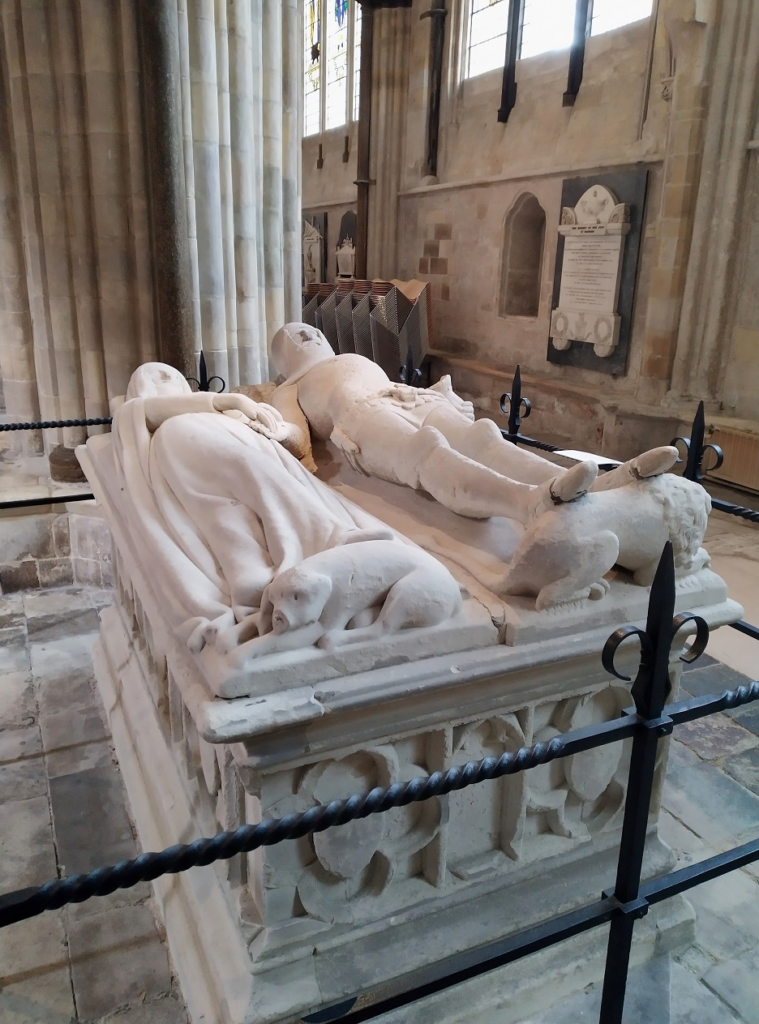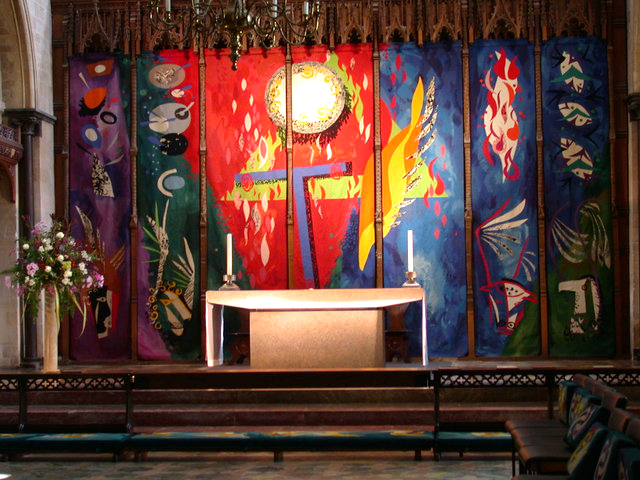Historian and CovSoc committee member, David Porter, reflects on a visit to Chichester Cathedral which has some interesting links to Coventry. David writes….
In the course of a recent visit to Chichester, I particularly enjoyed sampling the Cathedral’s eclectic mix of architecture and art.
While strolling through the nave, I happened to overhear one of the guides mention the name Philip Larkin to some visitors and so I stopped to listen in on the conversation, which concerned one of the poet’s most famous pieces entitled An Arundel Tomb. And there it was – the tomb which had so intrigued Larkin when he saw it in January 1956:

The couple depicted in effigy are taken to be the tenth Earl of Arundel (died 1376) and his wife Eleanor of Lancashire (died 1372), who had in fact originally been entombed within Lewes Priory. Thanks to the depredations of Thomas Cromwell and his henchmen at the time of the Dissolution – as a result of which the Priory was demolished – the tomb was relocated in 1537 to Chichester, where over time the effigies became separated and quite badly damaged.
As the guide went on to explain, it was not until the Victorian period that the couple were finally reunited thanks to the involvement of Edward Richardson, who was entrusted with the tomb’s restoration. By this time, the effigies had been so badly neglected that their hands had disappeared and so the sight of the couple holding hands which so affected Larkin when he saw them – as immortalised in the poem below – was actually the result of Richardson’s efforts:

Intriguingly, the apparent connections with Coventry do not end with Larkin. Just visible through the choir screen below is the very colourful tapestry designed by John Piper, who also designed the Baptistry window for Coventry Cathedral:
The tapestry was commissioned in 1964 and woven in France in a village called Felletin, which is where Graham Sutherland’s tapestry now hanging at the far end of Coventry Cathedral was also produced.
Racing ahead of myself, this series of coincidences led me to jump to the conclusion that the authorities in Chichester had attempted to emulate Sir Basil Spence’s stated intention to make Coventry Cathedral a “casket with many jewels inside” by following his practice of commissioning artists to produce artworks for his new structure, and yet this appears not to have been the case.
To explain, in 1955 a man called Canon Walter Hussey was appointed Dean of Chichester, having previously served at St Matthew’s Northampton. He was clearly a man of vision in all senses in that – like Spence – he was also very keen to commission noted artists to produce works of art, which goes to explain the presence today for example of a window by Marc Chagall at Chichester.
More pertinently, in 1946 Spence had visited St Matthew’s Northampton and was struck by a painting in the church entitled The Crucifixion, which was the work of Graham Sutherland. It was this painting which prompted Spence in 1951 to commission Sutherland to produce the design for the tapestry which we see today in Coventry, and so instead of Hussey ‘copying’ the practice of arranging for modern works by contemporary artists to be installed in ecclesiastical settings, it would appear that it was Hussey himself who was in the vanguard in this respect.
Casting aside my earlier faulty inference, I can instead strongly recommend to anyone a visit to the rather wonderful Chichester Cathedral, where the visitor from Coventry might like me enjoy spotting the similarities to and connections with Coventry – to whet the appetite if you do pay a visit there, as an example of yet another connection look out for a Graham Sutherland painting on display in the Cathedral!
David Porter: 30th August 2024
Editor’s Notes
There is an interesting mistake in Larkin’s poem. Larkin has got his lefts and rights muddled up. He writes of the earl’s left- hand gauntlet which is clasped empty in his right hand. In fact it is the other way round.
Another link between Coventry and Chichester, is the artist Hans Feibusch, who painted the amazing mural in St. Mark’s Church in Hillfields. As well as the Feibusch artwork in the Cathedral, Chichester has the Pallant House Gallery which houses the archive and studio of Hans Feibusch. The Bishop of Chichester was instrumental in bringing Feibusch to fame in the UK.

